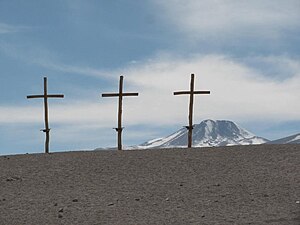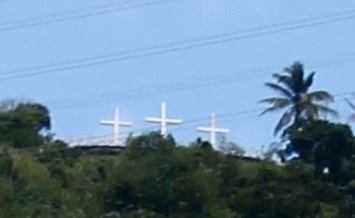
A calvary is a type of monumental public Christian cross, sometimes encased in an open shrine. Usually a calvary has three crosses, that of Jesus Christ and those of impenitent thief and penitent thief.
History
Calvaires in France

The oldest surviving calvaire, dating to between 1450 and 1460, is in France at the Chapelle Notre-Dame-de-Tronoën in the town of Saint-Jean-Trolimon, in south Finistère, near the Pointe de la Torche. This is raised on a large base which also includes carved representations of the Last Supper and scenes from the passion. Calvaires played an important role in Breton pilgrimages known as Pardons, forming a focal point for public festivals. In some instances the Calvary forms part of an outdoor pulpit or throne.
Calvaires are to be found in large numbers throughout Brittany, and come in many varied forms. Breton calvaries typically include three-dimensional figures, usually representing the Virgin Mary, the apostles, and saints, attending the Crucifixion itself.
A 16th-century calvaire from Louargat, Brittany, transplanted to serve as a World War I memorial, stands at the Carrefour de la Rose near the Belgian town of Boezinge north of Ypres.

The most notable Calvary monument outside Brittany is at Lourdes. This was specifically intended to represent Breton Catholicism. It was created by the sculptor Yves Hernot in 1900 as a gift to Lourdes from the main Breton dioceses: Rennes, Vannes, Quimper and Saint-Brieuc. The monument comprises a single central cross set within a raised square base at each corner of which a statue of one of the witnesses to the crucifixion is placed.
In northern France and Belgium, such wayside calvaries erected at the junction of routes and tracks "function both as navigation devices and objects of veneration", Nicholas J. Saunders has observed "Since medieval times they have fixed the landscape, symbolically acquiring it for the Christian faith, in the same way that, previously, Megalithic monuments marked prehistoric landscapes according to presumed religious and ideological imperatives".
Elsewhere

In Southern Italy calvaries are common. A typical variation is the Calabrian calvary, which includes 3 or more paintings of the Passion of Jesus on a wall surmounted by a cross and protected by a low fence.
Gallery
Crucifixes
-
 Calvary in Napajedla, Czechia.
Calvary in Napajedla, Czechia.
-
Calvary of Pontchâteau, Morbihan, France.
-
 Calvary in Tandil, Argentina.
Calvary in Tandil, Argentina.
-
Calvary in Baguio, Philippines.
-
 Calvary in Pleubian, France
Calvary in Pleubian, France
-
 Kalvárie in Kovářov
Kalvárie in Kovářov
Crosses
-
 Calvary at Toconao in Chile.
Calvary at Toconao in Chile.
-
 Calvary in Kazimierz Dolny, Poland.
Calvary in Kazimierz Dolny, Poland.
-
 Calvary in County Donegal, Ireland.
Calvary in County Donegal, Ireland.
-
 Calvary at Paete, Philippines.
Calvary at Paete, Philippines.
See also
References
- New York Times, Brittany's Church Towns Harris, AP, October 16, 1994
- "Thomas Hovenden, Calvary Monument, France", Woodmere Art Museum
- Saunders 2003:10 and illus.
- Don Sharkey, After Bernadette: The Story of Modern Lourdes, Kessinger Publishing, 2005, p.92.
- Saunders, "Crucifix, Calvary, and Cross: Materiality and Spirituality in Great War Landscapes", World Archaeology 35.1, The Social Commemoration of Warfare (June, 2003:7–21), p. 9.
